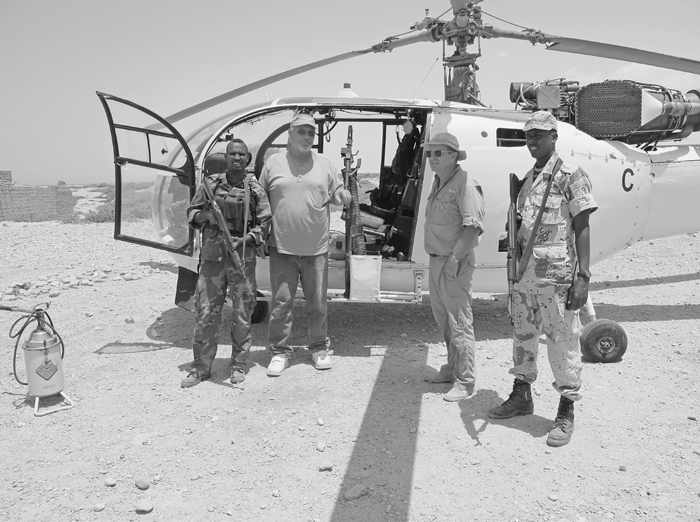
Gunhip pilot Neall Ellis (second from right) in front of the ageing Alouette III. (Photo Rudolf van Heerden)
One of the quirks of fighting an insurgency in Africa is that the government involved will quite often know exactly from where a terrorist group like al-Qaeda is operating. For reasons known only to itself, however, it will ignore both its presence as well as any potential threat factor. To some, the situation is sometimes referred to as a ‘head-in-the-sand syndrome’, the argument being that by tomorrow the menace might have disappeared.
Former South African Air Force (SAAF) colonel and mercenary, Neall Ellis, served in Somalia’s remote north for several years, flying a lone Alouette III helicopter attached to the Puntland Maritime Police Force (PMPF).
Though the helicopter was already decades old, and a veteran of Pretoria’s border wars, its role was far more illustrious than the unit itself. The makeshift unit, comprised solely of soldiers of fortune, all land- or sea-bound, offered no co-pilot, no emergency equipment, no backup if something went wrong on a flight into the interior. Added to this, maintenance throughout was at an absolute minimum.

Gunhip pilot Neall Ellis (second from right) in front of the ageing Alouette III. (Photo Rudolf van Heerden)
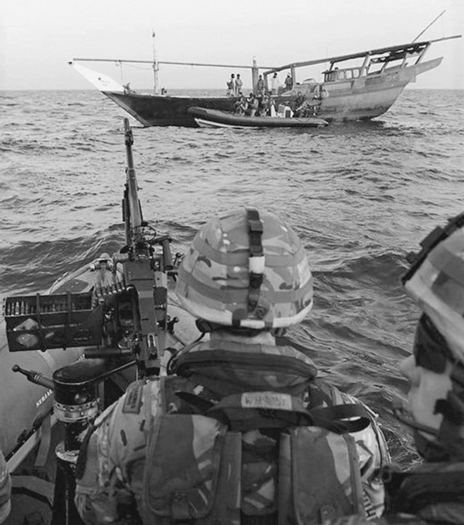
British patrol boats from the frigate HMS Monmouth stop and search, Arabian Gulf. (Photo Ministry of Defence)
There were flights when Ellis was tasked to fly out to sea and check on suspect boats. That, he confided, was dodgy, since he was never issued with any rescue gear, plus, communications being suspect, if he did go down over open water, there was no guarantee that a boat would be sent out to search for him. Curiously, the people backing his unit were Gulf-state Arabs, all of whom oil millionaires, so the aberration was culpable.
Nellis, as his friends call him, recorded some of the events as they happened while with the Puntland police.
The Puntland-based al-Qaeda-linked terror group, which Ellis and those South African mercenaries who were there before him were tasked to counter, had, and still has, a number of isolated bases in a range of mountains to the immediate east of the main military airport at Bosaso. This is difficult, mountain country with few access paths, making a surreptitious approach by a military squad all but impossible.
Also, while high ground only tops 2,000m, it was labelled by the Puntland authorities as a no-fly zone, as was the case when the gunship was operational. (The helicopter was eventually grounded because of a lack of spares.) The Puntland, however, is not only home to al-Qaeda, housing as it does other insurgency groups.
Ellis told Jane’s Defence Weekly that it was an open secret that there was a major al-Qaeda base in the desert barely 10km from Bosaso airport, a small town in the north of the country about 500km east of Djibouti. The consensus among expatriates working there was that it was only a matter of time before the sprawling complex came under attack.1
It is worth mentioning that the base commander several times asked for permission to launch a strike, but each time the matter was referred to the president in the Puntland regional capital of Garowe, situated in the desert more than 300km to the south. The answer that came back was emphatic: do nothing!
Prior to Ellis flying for the Puntland government, former SAAF helicopter gunship pilot, the late Arthur Walker had the job. He was also a former mercenary who had served with Executive Outcomes in Angola and Sierra Leone.2
Apparently not much has changed since Walker went home as the camp is still there. Indeed, it is now well established in the foothills of Puntland’s Golis Mountains that fringe this stretch of the north-west Indian Ocean adjacent to the Red Sea. So much so, that each time aircraft or helicopters attached to the Puntland air wing approach, they are fired on by Islamic militants.
The Golis range is ideally situated for use by insurgents as a secure base for moving weapons, explosives and other military hardware needed by al-Shabaab cadres in their war against the authorities and African Union (AU) forces. It says a lot that virtually all the suicide bombs recently detonated in Mogadishu had their origins in Puntland, from where the materiel was taken southwards by road, a distance of about 1,500km.
How these revolutionaries managed to pass unchallenged through dozens of road blocks en route is not certain. Clearly, a fundamentalist network has a lot to do with it.
A reliable intelligence source from Somalia recently returned to his home base in Pakistan, where, in an extensive debriefing, it was disclosed that the northernmost region of this embattled African land had become a focus of al-Qaeda insurgency, intent on infiltrating parts of northern and eastern Africa. For many of them, Puntland was their first point of entry. Also, the bombs employed towards the end of 2013 in the destruction of Westgate in Narobi, Kenya’s largest shopping mall, came from there.
Of note here is the fact that Puntland, about the size of Kansas, makes up about a third of Somalia’s geographical area. With a population of about four million, Ellis and his associates were expected to cover an enormous area with a single one-engine helicopter.
Moreover, the country has been a semi-autonomous state for almost two decades, having broken away from the central government in 1998, partly because of tribal differences and the fact that locals regarded Mogadishu as ‘ungovernable’.
Unquestionably, Puntland’s biggest single problem today is one of identity. The fledgling state has not been recognized by a single country. As expected, the territory’s original split from the central Mogadishu government did not go smoothly. Immediately after declaring itself independent, sporadic fighting broke out between Puntland and Somaliland over the ownership of the Sool and Sanaag regions, both claimed by Puntland based on ethnicity.
Violence also accompanied a political power struggle in 2001 between rival claimants to the Puntland leadership. Overall, it was, and still is, in a state of flux, hindered by a pervasive al-Qaeda presence.
Security in the Horn of Africa has deteriorated markedly in recent years. In Djibouti, the focus of American military action against Yemeni- and Somalibased militants linked to al-Qaeda, the Pentagon moved its drone operations from Camp Lemonnier, the former French Foreign Legion headquarters on the Red Sea, to an undisclosed location in the desert interior.
The reasons for moving the United States’s prime naval expeditionary base in the region to a more secure location were basic. There had been at least half a dozen crashes of these unmanned aerial vehicles, which, Washington declared, had raised safety concerns, not least because many Djibouti nationals have family connections across the border in the Yemeni target region.
The Red Sea operational base has been a major counter-terrorism centre for the Pentagon for more than a decade. The Americans run daily flights of General Atomics MQ-1 Predator surveillance drones across the narrow stretch of ocean into the Yemen and surrounding areas, which have resulted in a series of air-to-ground strikes against Islamist rebel groups.
Al-Qaeda’s influence in this enormous region is powerful, stretching all the way from Yemen, through Somalia to Mogadishu, and farther afield into the former British territories of Kenya and Tanzania.
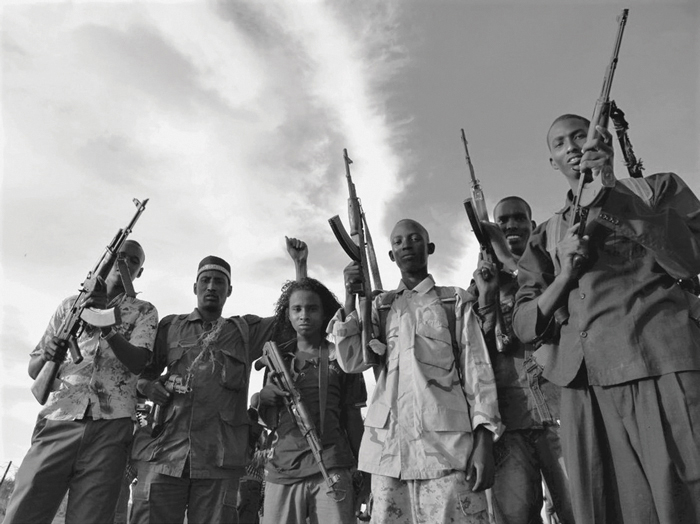
Jubaland Administration soldiers celebrate after rescuing al-Shabaab hostages in Kismayo. Jubaland, on the southern Somali border with Kenya, like Puntland, is yet another autonomous entity within Somalia. (Photo Ramadan Mohamed)
Somalia’s capital lies more than 1,000km by air to the south of Djibouti. For decades, the city has been the focus of terrorist activity by al-Shabaab, the most active al-Qaeda affiliate, responsible for terror attacks in several neighbouring countries including Kenya. The murder of dozens of civilians in a Nairobi supermarket in 2013 was a case in point.
Other attacks included car bomb and IED attacks against Western and African Union interests in the city, and a Kenyan university campus at Garissa in 2015 in which 148 students were killed and 79 wounded. Of greater significance, however, have been the numerous attacks on well-defended African Union military elements in Somalia itself.
An even gloomier picture emerged in a more recent report titled ‘Is the Coalition Fighting al-Shabaab Falling Apart?’ compiled by Joshua Meservey, Policy Analyst, Africa and the Middle East at the Heritage Foundation (a notable authority who spent years in Africa) and Kelsey Lilley, associate director of the Atlantic Council’s Africa Centre in the United States.
The terror group launched three deadly attacks in October 2016: another in a town in Kenya, a mosque in Mogadishu, and on an African Union military base in the country’s strategically important Hiran region.
More troublingly, they declared, Ethiopian troops abruptly withdrew the same month from a base in Halgan, also in Hiran, the third town that Ethiopian forces had abandoned, though there were reports that they might have pulled out of almost a dozen by the end of 2016. Their report states that ‘Addis Ababa has not confirmed why it left Hiran exposed, but it is likely repositioning its forces to respond to large-scale domestic protests that have rattled the Ethiopian government’. They suggest that:
The strategic Ethiopian withdrawal is problematic because it adds to the growing strains on the African Union Mission in Somalia (AMISOM), the anti-al-Shabaab military coalition, of which Ethiopia is a member. Moreover, ANISOM is due to start leaving Somalia in late 2018, but the growing pressure on its members suggests that an even earlier exit is possible. AMISOM’s other major troop-contributing countries, Burundi, Uganda, and Kenya, are all vulnerable to political upheaval of the sort that appears to have Ethiopia contemplating a drawdown.
This should set off alarm bells from Mogadishu to Washington. AMISOM is the only capable ground force battling al-Shabaab, and it is critical to protecting the highly fragile and reversible military gains made against the group.
An all-out fracturing of the mission would have dire consequences for the fight to defeat al-Shabaab.
It is notable that when preparing for a visit to the Somali capital in 2016, this author was warned not to leave the security of the city’s airport complex without a reasonably well-armed military escort.
There have been several serious attacks in Puntland itself, including a massive vehicle-borne IED attack on members of the air wing. Ellis was among them when they were on an end-of-the-month visit to the bank in Bosaso town. They were clearly tracked and targeted by insurgents. There were numerous casualties, including several people killed. By some accounts, the Level-6 Ford-350 armoured vehicle took the brunt of the blast, saving the lives of several PMPF members, Ellis among them.
Interestingly, some of the survivors were later debriefed by four of Puntland’s senior security officials. Two of those officials had already survived car bomb attacks. In addition, one of them emerged unscathed from an assassination attempt, while a fourth had his Bosaso house burned down in an al-Qaeda attack.
Reports that circulated afterwards disclosed that the bomber was a 30-yearold man who had recently married a widow. He had apparently been recruited by al-Qaeda.
Since then, a lot more has gone wrong in trying to counter insurgency in the Horn of Africa.
Recent reports confirm that al-Shabaab now has access to 82mm mortars, purportedly out of Pakistan and Iran. Because of long-standing arms sanctions against Puntland, government security forces have nothing to match this weapon so are unable to counter this threat, even though detachments of United States Marines are currently training the country’s security forces.
The fact is, insurgent groups in Puntland have achieved a significant foothold, and infiltrations from the Yemen are well planned and coordinated. As this expansive desert land lies adjacent to the Saudi Peninsula, insurgents employ small motorized ‘go-for’ boats and Arab dhows to cross the narrows. This entire region is now regarded as extremely volatile and dangerous by Western intelligence experts.
While Bosaso town, an untidy urban desert sprawl a short drive from the airport, has not been heavily targeted as yet, nobody working for the PMPF goes there without an escort of at least six soldiers, more if possible because of the potential of being blasted by suicide bombers.
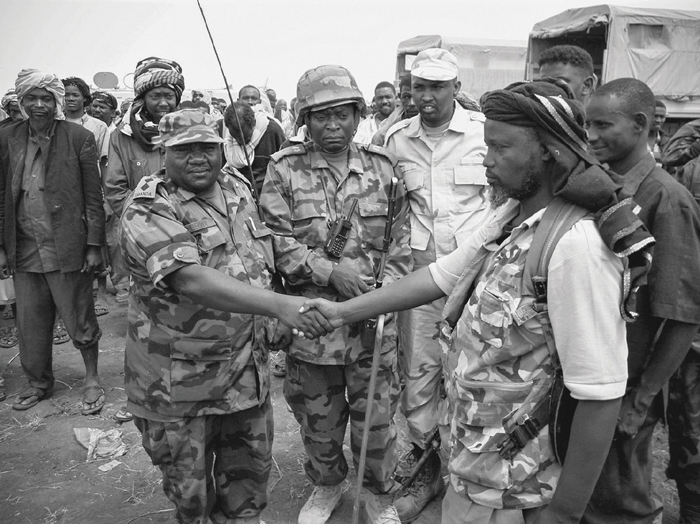
Al-Shabaab fighters disengage and lay down arms, 22 September 2012. (Photo AMISOM Public Information)
Bosaso remains an isolated outpost. Although served by a twice-weekly Antonov flight from Berbera in quasi-independent Somaliland 500km to the west, it is not a reliable link, even if it is the only access by air into the territory.
What does run like proverbial clockwork is the almost new Bombardier Dash-8 aircraft that touches down at Bosaso at 0800 hours every morning with the region’s supply of qat.
At the time that I reported on events in Puntland for Jane’s, there was some disquiet among those working for Puntland’s air wing, in part because the 40-year-old Alouette, with a single mounted PKM machine gun, was simply not up to the task of covering the vast distances required of it.
In an effort to remedy the situation, Ellis – always the pragmatist – suggested that a MBB/Kawasaki BK117 helicopter (a 9-seater in a two-plus-seven configuration), be acquired by the Garowe administration. The antiquated Alouette (potentially one-plus-six) could take only the pilot and two passengers over the long distances that this machine was required to traverse with a full load of fuel.
He explained that from Bosaso, the flying time to Garowe was ninety minutes, then another ninety minutes to Bargaal, followed by an even longer haul to get to the coastal town of Hafun.
In between the terrain is sparsely populated desert with no water or fuel points, in which security force patrols are rare. This is one of the reasons why Ellis liked to take along his own version of a desert still to make his own water in the event of his having to put down and being stranded.
Reasons for these anomalies are deep-seated. Puntland’s air-wing operations are totally financed by and under the control of officials from the United Arab Emirates. While the Garowe-based Puntland Development Group (PDG) has the final say in most matters, there is little cooperation between the two principals, in part because of corruption on a massive scale.
It is no secret that pirates operating from Puntland make fair provision for many members of that government with any ransom money that is paid for ships released. A case in point is the $12 million handed over by Western owners for two ships and their crews that were released in 2013, of which a significant proportion went to Puntland ministers as well as heads of security services, including police chiefs. As a consequence, pirates operating from Puntland, until fairly recently, were free to operate in the adjacent Red Sea and Indian Ocean waters, almost with impunity.
Ellis also pointed at a significant amount of human trafficking into Puntland from the Yemen. Some of these victims were brought into the country in Arab dhows, but even when apprehended, the law is rarely allowed to take its course.
Five dhows with a large number of illegals were apprehended by the Alouette when Ellis still ran the air wing. They were escorted to Bosaso where the boats were impounded and their crews arrested. Yet inexplicably, both boats and crews were released weeks later, and allowed to leave the country without those involved being criminally charged. The word was that somebody in the Yemen had paid an ‘incentive’ to local officials for this to happen.
A notable success involving ‘freelance aviators’, when Arthur Walker was still in Bosaso, was the rescue of twenty-two sailors who had been held hostage by pirates on board the Panamanian-registered freighter Iceberg for three years. Several crew members of the crew had died in the interim, while others had been savaged and tortured by their Somali guards. The Iceberg’s chief engineer had had his ears cut off because he ‘did not listen’. His incarcerators then crushed his leg with a steel bar so that he could not escape.
Aware of the fate of these men, the Puntland authorities tried to negotiate with the pirates, and indeed, they attempted to do so several times. However, their entreaties to release the prisoners were always rejected.
Finally, in December 2012, a small group of mercenaries in the employ of the Puntland Maritime Police Force (PMPF) attempted to rescue the prisoners. About twenty ground troops, including a Puntland detachment led by former Executive Outcomes veteran Rudolf van Heerden, with Puntland Rear Admiral Abdurizak Diri Farah in overall control, launched an attack. The effort was backed by Walker at the controls of the Alouette gunship flying top cover.
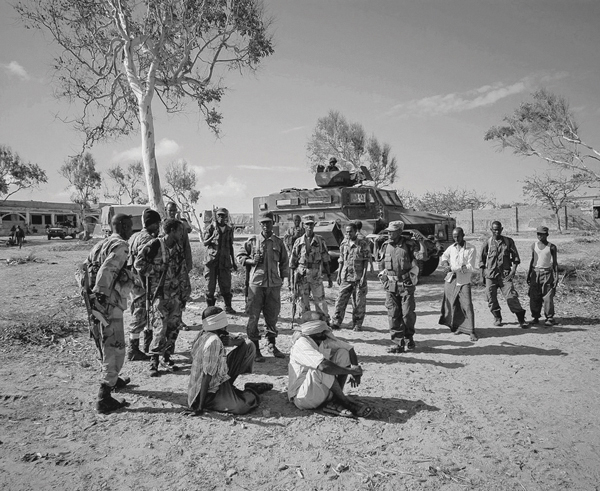
Al-Shabaab suspects guarded at a police station by SNA troops. (Photo Stuart Price)
Having brought some heavier weapons to bear, including a Russian 82mm smoothbore B-10 recoilless rifle and RPG-7s, the assault ended twelve days later when the pirates, using mobile phones, called their leaders to negotiate a truce through diplomatic channels in the Yemen.
Garowe agreed to exchange the hostages for the freedom of the pirates, the first time an independent military group had rescued a group of hostages from captivity while technically still at sea. The Iceberg, by then, had lost engine power and been driven ashore where it lay stranded. This development eventually resulted in an even deadlier threat being introduced into the security scenario.
With al-Qaeda-linked al-Shabaab forces having been driven out of some of their safe havens in southern Somalia, as a consequence of military ground and air action by African Union forces, Puntland experienced a surge of Islamist terrorism. Own sources indicate that there are now an estimated 300 al-Shabaab guerrilla fighters in Puntland alone, their ranks including several Egyptian jihadis.
Washington is aware of these developments following the withdrawal from Puntland of Bancroft Global Development, a military training group funded by the United Nations and the US State Department and headquartered in Washington DC and regionally in Mogadishu, that had provided training in a range of military services. This included a number of disciplines, from bomb disposal and sniper training, to supplying of military materiel and uniforms, which cumulatively forced the terror group to move into the area adjoining the Red Sea. In the interim, another American firm has been tasked to run security operations in Puntland. Several anti-pirate missions took place under its auspices.
Back in Puntland, the security assets of the PMPF are modest and hardly capable of dealing with the increased threat level. Prior to Bancroft pulling back to Mogadishu, a pair of upgraded Mil Mi-17s was ordered, but these were put on hold and only later delivered.
The force also lacks the support of the original 120 expatriate combatants fielded by Bancroft. Involved then was former US Navy Seal Erik Prince, founder and owner of Blackwater International who, for the Puntland operation, had partnered up with Lafras Luitingh, a former South African special forces operative who had originally been involved with Executive Outcomes. About twenty private military contractors remain, all part of the PMPF air-wing infrastructure.
Still at the unit’s Bosaso air base, is an Antonov An-26 with a rotating Russian crew. This aircraft is routinely tasked to bring in supplies, troop rotation, and the delivery of fuel and equipment to PMPF elements on distant operations.
This includes dropping 44-gallon drums of fuel at sea for the three Zodiac RHIB (rigid-hulled inflatable boat) high-performance craft fitted with 400hp Volvo twin-screw inboards and DShK 12.7mm heavy machine guns mounted on their prows. All of them are used for anti-piracy operations by the PFMF. According to Ellis, Jet-A1 fuel is also dropped by parachute for the helicopter when needed.
Additionally, the PMPF has at its headquarters base at Bosaso three modified Ayres Thrush crop-spraying aircraft, armed with four-barrelled mini-guns capable of firing 4,000 rounds a minute and American-supplied underwing air-to-ground rockets. Adapted for close-air support roles and labelled V-1-A Vigilantes’, the aircraft were originally developed for the US Department of State for anti-narcotics crop-spraying roles, NEDS (Narcotics Eradication Delivery System), in Central and South America and Southeast Asia. The machines are a useful adjunct to the limited airborne capability of the PMPF.
Another aviation element routinely spotted at the air base was a pair of military Russian-built Mil Mi-17s with upgraded 2,500hp engines. No photos were allowed to be taken anywhere near the base or of any of the American crew members. What was known was that one of the pilots was a woman, but the pilots had no contact with anybody linked to the PMPF. Instead, those flying the Mi-17s liaised solely with senior military officers within the Puntland government.
Interesting, the pair of Mi-17s had been completely modified to include Western avionics, which, by some accounts, is a first for the Russian helicopter. Its original clamshell rear doors were removed and a ramp installed, very much in line with what was originally sported by the French-built SA 321 Aérospatiale Super Frelon helicopter, in all probability to allow for the mounting of automatic weapons for firing out of the rear. The Mi-17s regularly used the same shooting range for training as the PMPF helicopter, which lies a short distance from Bosaso.
That was the situation until Ellis returned to South Africa in 2013. Yet while he was still operating out of Bosaso, a major al-Shabaab cell was uncovered near the town. The base has come under attack at least once in recent months.
It was not the first time this had happened. While Arthur Walker was still around, local residents reported the presence an Arab dhow, purportedly out of the Yemen. It had entered one of the lagoons along this stretch of the northern coast where it unloaded a cargo. When some local residents began to approach the boat, its contraband was hurriedly buried and the crew fled. In a search the following day, that involved the unit’s helicopter and PMPF ground forces, a cache of arms was uncovered, but it soon became clear that only part of the weapons’ shipment had been unloaded.
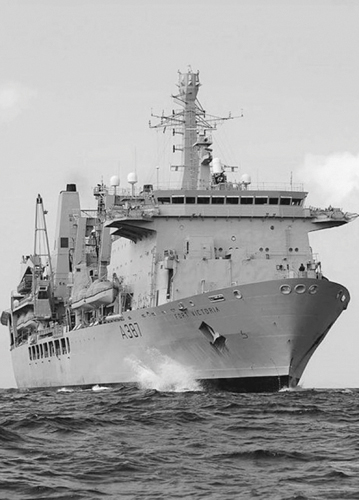
British ship RFA Fort Victoria passes Mogadishu during Operation Capri, the counter-piracy effort off the Somalian coast. (Photo Ministry of Defence)
Recovered by the security forces were 220 RPG-7 grenades (but no launchers), 40kg of TNT (most likely for use in IEDs), 200 electric detonators incorporating the latest technology, four rolls of cordtex, and 20kg of ammonium nitrate in sacks, a fertilizer commonly used in the manufacture of explosives.
Also uncovered was a quantity of Russian B-9 (slightly smaller than the B-10 recoilless gun) ammunition, as well as boxes of AK-47 and PKM 7.62mm ammunition and hand grenades.
Another dimension to the Somali imbroglio in the north is the vast deposits of oil that have been discovered in a string of desert regions to the south of Bosaso. Although Puntland’s President Abdiweli Mohamed Ali Gas visited Mogadishu in 2014 where he was well received by the president of the central government, the oil issue topped the agenda.
Differences over piracy featured prominently. For more than a decade, this issue has achieved a high-level international profile, resulting in several nations, including the US, India, Russia, France, Britain and other NATO countries and a dozen more, deploying warships around Somalia to protect shipping. China is now also involved in naval patrols.
Still more worrying is the fact that piracy is widely viewed by most people in Somalia as a socially acceptable and lucrative lifestyle, which has attracted to its ranks former fishermen, ex-militiamen, and technical experts needed to keep pirate boats and their mother ships at sea.
There are also many people there who are quite outspoken in their defence of attacks on foreign ships. They maintain, often with vehemence, that it is a justified response to illegal fishing and the illegal dumping of toxic waste along Somalia’s long and poorly policed coastline.
What is ironic about these anomalies is that having established the Puntland Maritime Police Force as a reasonably effective body dedicated to countering piracy, those airmen, ground forces and support elements at Bosaso who are involved in these activities are actually working against the government that pays them.
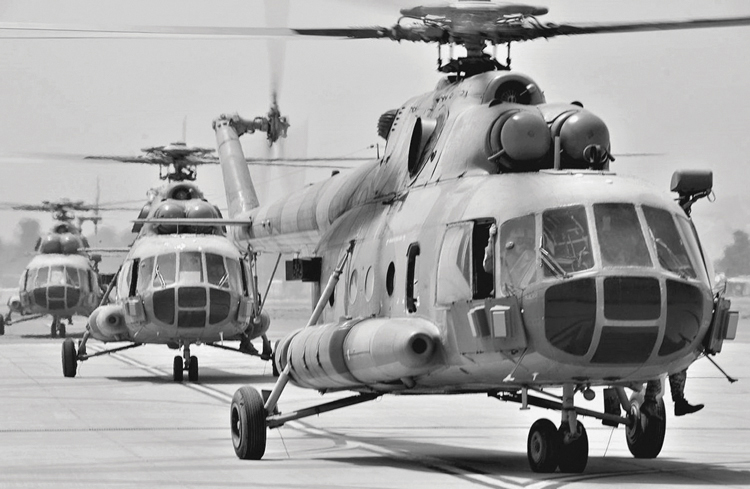
Russian-built Mil Mi-17 helicopters. (Photo NATO)
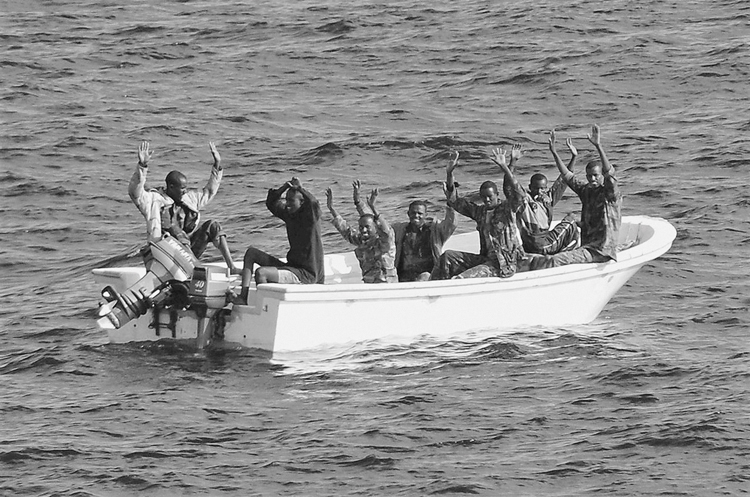
Suspected pirates apprehended by a VBSS crew from the USS Vella Gulf. (Photo Jason R. Zalasky)